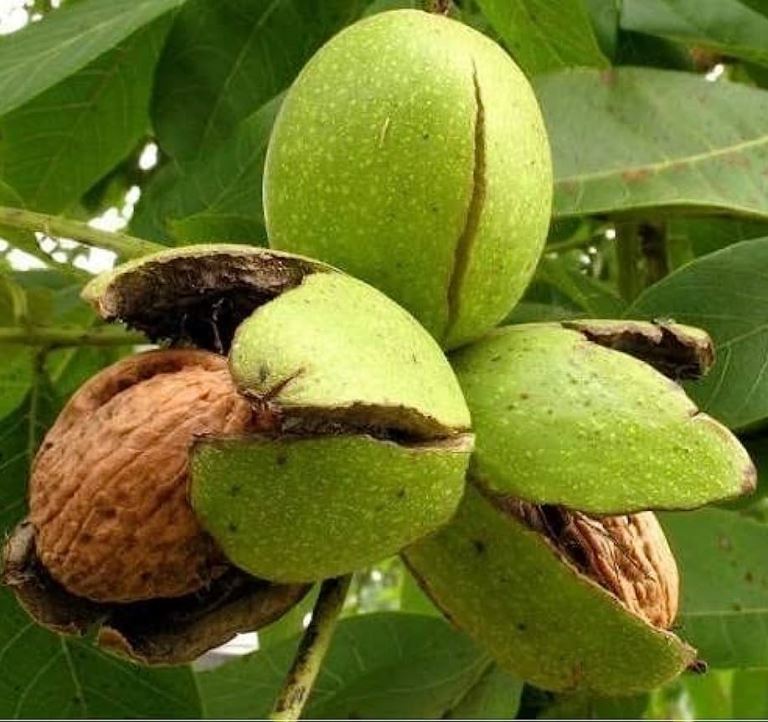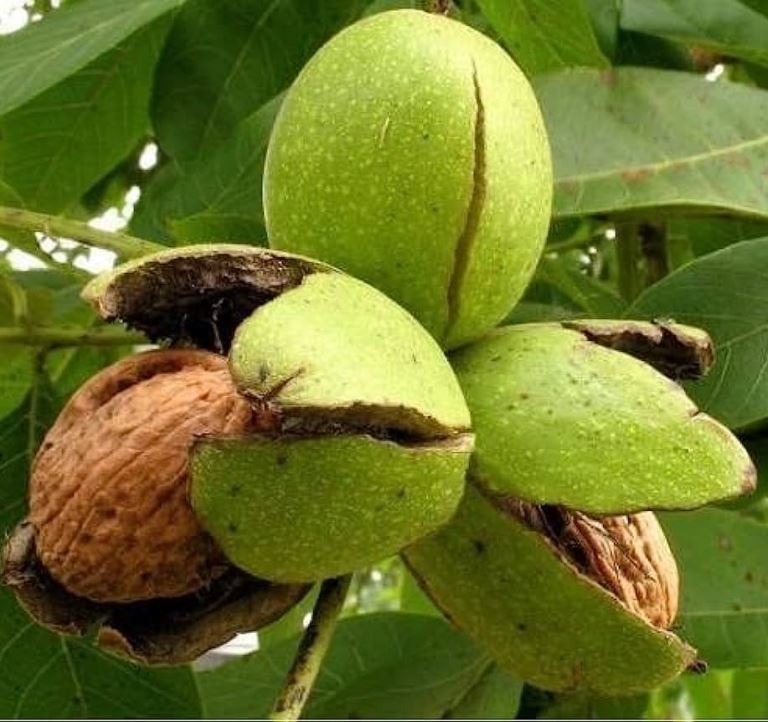
Brief Intro
Walnut Plant (Grafted) – Akhrot Tree
Basic Product Details
- Scientific Name: Juglans regia
- Common Names: Walnut Tree, Akhrot Plant, English Walnut
- Plant Type: Deciduous, Fruit-bearing, Grafted Variety
- Plant Height: 12-24 inches (approximately)
- Pot Size: 6-8 inch nursery pot
- Soil Type: Well-draining, loamy, slightly alkaline to neutral soil
- Sunlight Requirement: Full sunlight
Product Overview
The Walnut Plant (Grafted) – Akhrot Tree is a high-yielding, fast-growing variety known for producing large, high-quality walnuts. This grafted plant ensures earlier fruiting compared to seed-grown varieties, making it an excellent choice for home gardens, orchards, and commercial farming. Walnuts are nutrient-rich, packed with omega-3 fatty acids, antioxidants, and essential minerals, making them a valuable addition to a healthy diet.
Features and Characteristics
Growth Habit
- Deciduous tree that sheds leaves in winter.
- Can grow up to 30-50 feet in open ground.
- Suitable for backyard gardens, farmlands, and large containers.
Leaves & Flowers
- Pinnate, green leaves with a fragrant aroma.
- Produces yellow-green catkin flowers before fruiting.
Fruits
- Hard-shelled walnuts with a rich, creamy nut inside.
- High in protein, healthy fats, and essential vitamins.
- Used in culinary, medicinal, and commercial applications.
Uses of Walnut (Akhrot)
Culinary Uses
- Eaten as a raw snack for its rich, nutty flavor.
- Used in desserts, baking, and traditional sweets.
- Added to salads, smoothies, and health drinks.
Health & Medicinal Benefits
- Boosts brain function with omega-3 fatty acids.
- Supports heart health and reduces bad cholesterol.
- Rich in antioxidants, promoting overall wellness.
Harvesting and Farming Details
Farming Requirements
Climate
- Grows best in temperate to subtropical climates.
- Requires cold winters (chilling period) for proper fruiting.
Soil
- Prefers well-draining, loamy, and slightly alkaline soil.
- Avoid waterlogged or clay-heavy soil.
Planting Season
- Best planted in spring or autumn.
Spacing
- Maintain 20-25 feet distance between trees for optimal growth.
Harvesting
- Grafted walnuts start producing within 4-6 years.
- Harvest when walnut husks split open and nuts fall.
- Dry nuts properly before storage.
Care Tips
Light
- Requires full sunlight (at least 6-8 hours daily) for good growth.
Watering
- Water deeply once a week, keeping the soil slightly moist.
- Reduce watering in winter.
Fertilizer
- Apply organic compost and NPK fertilizer during the growing season.
- Add potassium and calcium supplements for better nut quality.
Pruning
- Prune to remove weak or dead branches and shape the tree.
- Encourages better airflow and fruiting.
Pest Control
- Watch for aphids, walnut husk flies, and fungal diseases.
- Use neem oil or organic pesticides as needed.
Benefits of Growing Walnut (Akhrot) Plant
Health & Wellness Benefits
- Homegrown organic walnuts are chemical-free and highly nutritious.
- Rich in essential fats and antioxidants, boosting immunity.
Economic Benefits
- High-value cash crop with strong market demand.
- Long-living tree with continuous fruit production.
Environmental Benefits
- Improves air quality and provides shade.
- Enhances biodiversity by attracting pollinators.
Placement Suggestions
- Best suited for large gardens, farmlands, and commercial plantations.
- Can be grown in large containers (at least 20 inches wide) for early years.
- Requires ample space due to its large growth potential.
Common Questions and Answers About Walnut (Akhrot) Plant
How long does it take for a grafted walnut tree to bear fruit?
Grafted walnut trees start fruiting within 4-6 years, while seed-grown ones may take 10+ years.
Can I grow walnuts in pots?
Yes, but only for the early years. Eventually, it needs open ground for full growth.
Does the walnut tree require full sunlight?
Yes, it needs 6-8 hours of direct sunlight daily for healthy nut production.
How do I know when walnuts are ready to harvest?
When outer husks split open, indicating the nuts are mature.
What is the best fertilizer for walnut trees?
Use organic compost, well-balanced NPK, and calcium-rich supplements.
Are walnut trees drought-tolerant?
They are somewhat drought-tolerant but grow best with regular deep watering.
Why are my walnut leaves turning yellow?
Possible reasons include overwatering, nutrient deficiency, or fungal infections.
The Walnut (Akhrot) Plant is a long-term investment that offers nutrient-rich harvests for generations. Start growing your own walnut tree today and enjoy fresh, homegrown Akhrot!
FAQs:
What is the Return Policy?
This product is Not Returnable. It may be replaced or refunded in case of damage or defective condition on a case to case basis.
How to cancel my order?
Cancellation for Live Plants is allowed before the dispatched. You can request cancellation through Your Orders page or by contacting customer service within that time.
What if i received damage product?
If a product is received in a damaged or defective condition, you need to contact the customer service within 1 days of delivery. Free of cost replacement or refund claim is available to you.


